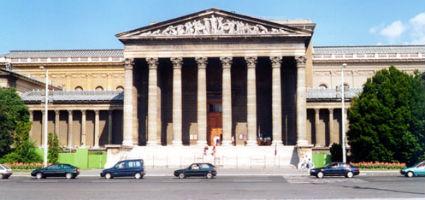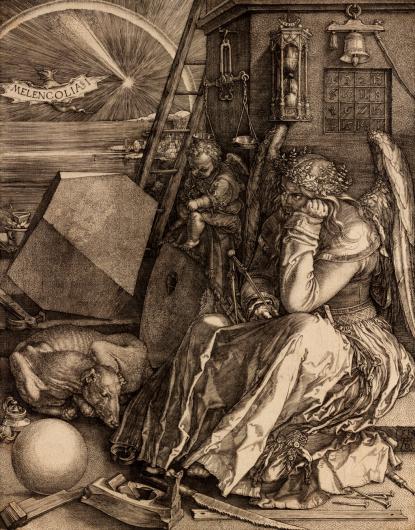2024. April 26. Friday
Budapest Museum of Fine Arts - Budapest
 |
Address: 1146, Budapest Dózsa György út 41.
Phone number: (1) 469-7100
E-mail: info@szepmuveszeti.hu
Opening hours: Tue-Sun 10:00-18:00
|
The exhibition has closed for visitors.
2007.09.07. - 2008.03.02.
Museum tickets, service costs:
|
Ticket for adults
(valid for the permanent exhibitions)
|
2800 HUF
|
/ capita
|
|
Ticket for adults
|
3200 HUF
|
|
|
Group ticket for adults
|
2900 HUF
|
|
|
Ticket for students
(valid for the permanent exhibitions)
|
1400 HUF
|
/ capita
|
|
Ticket for students
|
1600 HUF
|
|
|
Group ticket for students
|
1400 HUF
|
|
|
Ticket for pensioners
(valid for the permanent exhibitions)
|
1400 HUF
|
/ capita
|
|
Audio guide
|
800 HUF
|
|
|
Video
|
1000 HUF
|
The technique of engraving probably developed in the 1430's, in the rural goldsmiths' workshops of the Upper Rhine region. It originates from one stage of working metal: when the goldsmith cut the ornament into the surface of the metal with a burin, he applied paint on the design and pressed wet paper onto it, which attracted the paint from the grooves and created the negative impression of the engraved design on the plate. Goldsmiths used these early prints to check the accuracy of their ornaments as well as to record and disseminate their designs. At a later stage these reproduced compositions served as models for sculptors and painters. The method of applying paint on the engraved plate, wiping it off and imprinting it on paper could be repeated numerous times and hundreds or even thousands of prints could be made from one copper plate, depending on the quality of the copper plate, the depth of the incision made with the burin and the master's level of expertise in applying paint and printing. The early plates seen at the exhibition were made in the second half of the 15th century by Italian and German masters, among them Andrea Mantegna, Antonio Pollaiuolo, Martin Schongauer and Israhel van Meckenem.

The importance of 16th German engraving is primarily illustrated by the prints of Albert Dürer, the painter and graphic artist from Nuremberg, whose work represents the heyday of engraving. The 16th century is considered to be a fruitful period in the history of engraving not only in German-speaking areas: Lucas van Leyden, Hendrick Goltzius, Jan Saenredam, Aegidius Sadeler, Jacob Matham and Jan Muller of the Netherlands were among the most outstanding graphic artists of the period. The Italian artists of the 16th century are represented at the exhibition primarily by Giulio Campagnola, Marcantonio Raimondi and Giorgio Ghisi, while the French engravers featured at the exhibition are Jean Duvet and the members of the Fontainebleau School. The next two centuries are mostly known for reproductive graphics; therefore, the exhibition's organisers selected works from plates made based on the paintings of Pieter Pauwel Rubens and Antoine Watteau, and from French portrait prints.
The outstanding master of the 18th century was William Hogarth, many of whose plates are preserved in the Museum of Fine Arts. The 19th and 20th centuries gave way to other reproduction techniques and by then copperplate engraving had lost its significance. The exhibition therefore ends with works from the 18th century, presenting an overview of artistic works of four centuries. Some prominent masters will be represented with several plates in order to show their individual styles and innovative techniques. The exhibition will also provide an opportunity for visitors to learn about the tools used in engraving and the different phases of working copper plates.
Curators of the exhibition: Teréz Gerszi and Szilvia Bodnár.

The importance of 16th German engraving is primarily illustrated by the prints of Albert Dürer, the painter and graphic artist from Nuremberg, whose work represents the heyday of engraving. The 16th century is considered to be a fruitful period in the history of engraving not only in German-speaking areas: Lucas van Leyden, Hendrick Goltzius, Jan Saenredam, Aegidius Sadeler, Jacob Matham and Jan Muller of the Netherlands were among the most outstanding graphic artists of the period. The Italian artists of the 16th century are represented at the exhibition primarily by Giulio Campagnola, Marcantonio Raimondi and Giorgio Ghisi, while the French engravers featured at the exhibition are Jean Duvet and the members of the Fontainebleau School. The next two centuries are mostly known for reproductive graphics; therefore, the exhibition's organisers selected works from plates made based on the paintings of Pieter Pauwel Rubens and Antoine Watteau, and from French portrait prints.
The outstanding master of the 18th century was William Hogarth, many of whose plates are preserved in the Museum of Fine Arts. The 19th and 20th centuries gave way to other reproduction techniques and by then copperplate engraving had lost its significance. The exhibition therefore ends with works from the 18th century, presenting an overview of artistic works of four centuries. Some prominent masters will be represented with several plates in order to show their individual styles and innovative techniques. The exhibition will also provide an opportunity for visitors to learn about the tools used in engraving and the different phases of working copper plates.
Curators of the exhibition: Teréz Gerszi and Szilvia Bodnár.
